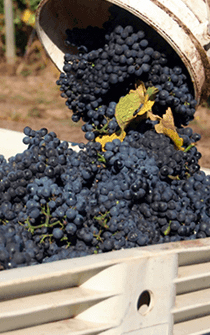Harvest

HARVEST
Throughout the history of wine, winemakers would use the sugar and acid levels of the grape as a guide in determining ripeness. Early winemakers tasted the grapes to gauge ripeness. Modern winemakers use a refractometer to measure high sugar levels and °Brix. In recent times there has been more of an emphasis on the “physiological” ripeness of the grape, usually in the form of tannins and other phenolics. Currently, tasting is the only way to measure tannin ripeness, which can take experience and skill to do accurately.
The harvesting of wine grapes is one of the most crucial steps in the process of winemaking. The time of harvest is determined primarily by the ripeness of the grape as measured by sugar, acid and tannin levels with winemakers basing their decision to pick based on the style of wine they wish to produce. The weather can also shape the timetable of harvesting with the threat of heat, rain, hail, and frost which can damage the grapes and bring about various vine diseases
.
